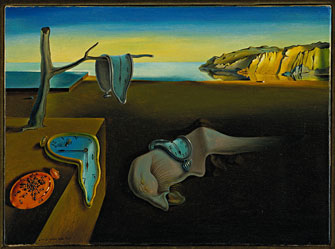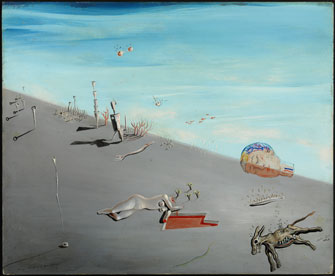Desperately Seeking a
Likable Side of Dalí

“The Persistence of Memory” (1931). © Salvador Dalí, Fundació Gala-Salvador Dalí/Adagp, Paris 2012
Beyond a grudging admiration for Salvador Dalí’s energy, enthusiasm and wit, I have never been a fan of the Catalonian artist. His paintings just don’t strike the chord that makes me respond intellectually or instinctively to a work of art. Nonetheless, I went to the exhibition “Dalí” at Paris’s Centre Pompidou with an open mind, hoping to find something that would shed new light on the artist or show me a side of his work I was unfamiliar with.
Unfortunately, I can’t report that that happened. Dalí the provocateur was such a media hound that almost everything about his extravagant life and art is already well known. The only real surprise for me was that early in his career (in the mid-1920s), before he adopted Surrealism, he dabbled in Cubism, not without talent but well after most artists had dropped the style.
This is an exhaustive show, the first major retrospective to be held at Pompidou since 1979, when Dalí (1904-85) was still alive. As is usual for this type of exhibition at Pompidou, it is well-presented and includes not only paintings, drawings and sculptures but many other documents, including books illustrated by the artist, a re-creation of the Mae West room in the Dalí Theatre and Museum in his hometown of Figueres in Catalonia, and a number of films made by and about him. The unsavory aspects of the man – his support for Spanish dictator Francisco Franco and his unabashed money-grubbing – are briefly mentioned in the show’s wall text.
The films include many of his often-clownish public performances, as well as the short 1929 film Un Chien Andalou, directed by Luis Buñuel and co-scripted by Dalí. The latter is full of references to his obsessions, which recur in many of the works on display, among them ants (which apparently symbolized death, decay and sexual desire), Vermeer’s painting “The Lacemaker” and rotting animal carcasses.
The curators would have done well to provide a little more information about individual works on display; many questions are raised that are not answered in the context of the exhibition. For example, is the surprisingly small “The Persistence of Memory” (1931) the first painting in which Dalí used the famous melting clocks? (It is.) I also wondered whether “Neo-Cubist Academy (Composition with Three Figures)” (1926), with its three monumental neoclassical figures against a background of beach, sea and rocky outcrop, was a Cubicized take on Picasso’s “Baigneur et Baigneuses” (1920-21) as it appears to be.
Trying to analyze why Dalí’s and most other Surrealist paintings leave me so cold, I looked for a long time at some of them, including a study for “Honey Is Sweeter than Blood”

Study for “Honey Is Sweeter than Blood” (1926). © Salvador Dalí, Fundació Gala-Salvador Dalí/Adagp, Figueres, Paris, 2012.
(1926), pictured here. Perhaps it’s the arbitrary arrangement of disparate things, which may have had meaning for the artist but that is not transmitted to the viewer. Or is it because there is no narrative to capture one’s attention (but there is no narrative in abstract painting either, which can still be extremely captivating and/or moving)? Who knows?
I did find a few paintings in the show that spoke to me, among them “Image Médiumnique-paranoïaque” (c. 1934), a crisply painted beach scene in soft, glowing colors. It shows two men who seem to be packing boxes in the lower right hand corner, a seated woman on the left, a man cycling on the horizon and a large shell in the foreground. Does it appeal because of the beauty of the colors, because of its air of melancholy mystery or because it portrays recognizable human beings and activities rather than the monsters common in Dalí’s work? Maybe all three.
Another painting that appealed to me was “Sun Table” (c. 1936), another beach scene, this one more in the Surrealist vein, with dream-inspired images: a boy in silhouette looks up at the sky on the lower right, with broken pottery and a crumpled pack of Camel cigarettes at his feet; a faceless man sits on a real Camel on the left, next to a sculpted bust on a column; and in the center foreground is a table holding three glasses with spoons – another recurring Dalí theme – on top of a rectangle of tiled floor. High in the sky above it all, the moon floats indistinctly in the blue sky.
This is an excellent exhibition for the legions of confirmed Dalí fans in the world, but I doubt that those who aren’t will be converted by it.
Centre Pompidou: 19, rue Beaubourg, 75004 Paris. Tel.: 01 44 78 12 33. Open 11am-9pm. Closed Tuesday. Métro: Rambuteau. Admission: €13. Through March 25, 2013. www.centrepompidou.fr
Reader Barney Kirchhoff writes: “Dalí is an interesting character who contributed a lot to modern art.
“He also helped create a tsunami of fake Dalís.
“I recall one incident in which he signed 17,000 sheets of blank paper on which anyone could print anything. People who bought these ‘signed prints’ were essentially buying an autograph.
“The scam was exposed when French customs seized a truckload of these signed blanks being smuggled into France in the 1980s.
“I tried to verify this on the Internet and found a partial account. If you Google ‘Mary Anne Martin Dalí,’ you will find a badly reproduced, truncated newspaper clip that gives some of the details.
“If you have one of these prints, you will be the proud possessor of a genuine fake Dalí melted watch. I wonder how many of them wound up in museums around the world.”
Reader Owen McGowan writes: “I’m forever convinced Dalí was a fraud, the way Warhol was, with the huge difference that Warhol, who was supremely uneducated and supremely intelligent – an awesome combo – knew he was and played accordingly.
“May I replay the evening when I walked into the St. Regis as Dali and entourage were walking out, nnd I said, ‘Good evening, Mr. Daly’.”
Reader reaction: Click here to respond to this article (your response may be published on this page and is subject to editing).
Please support Paris Update by ordering books from Paris Update’s Amazon store at no extra cost. Click on your preferred Amazon location: U.K., France, U.S.
More reviews of Paris art shows.
© 2012 Paris Update
